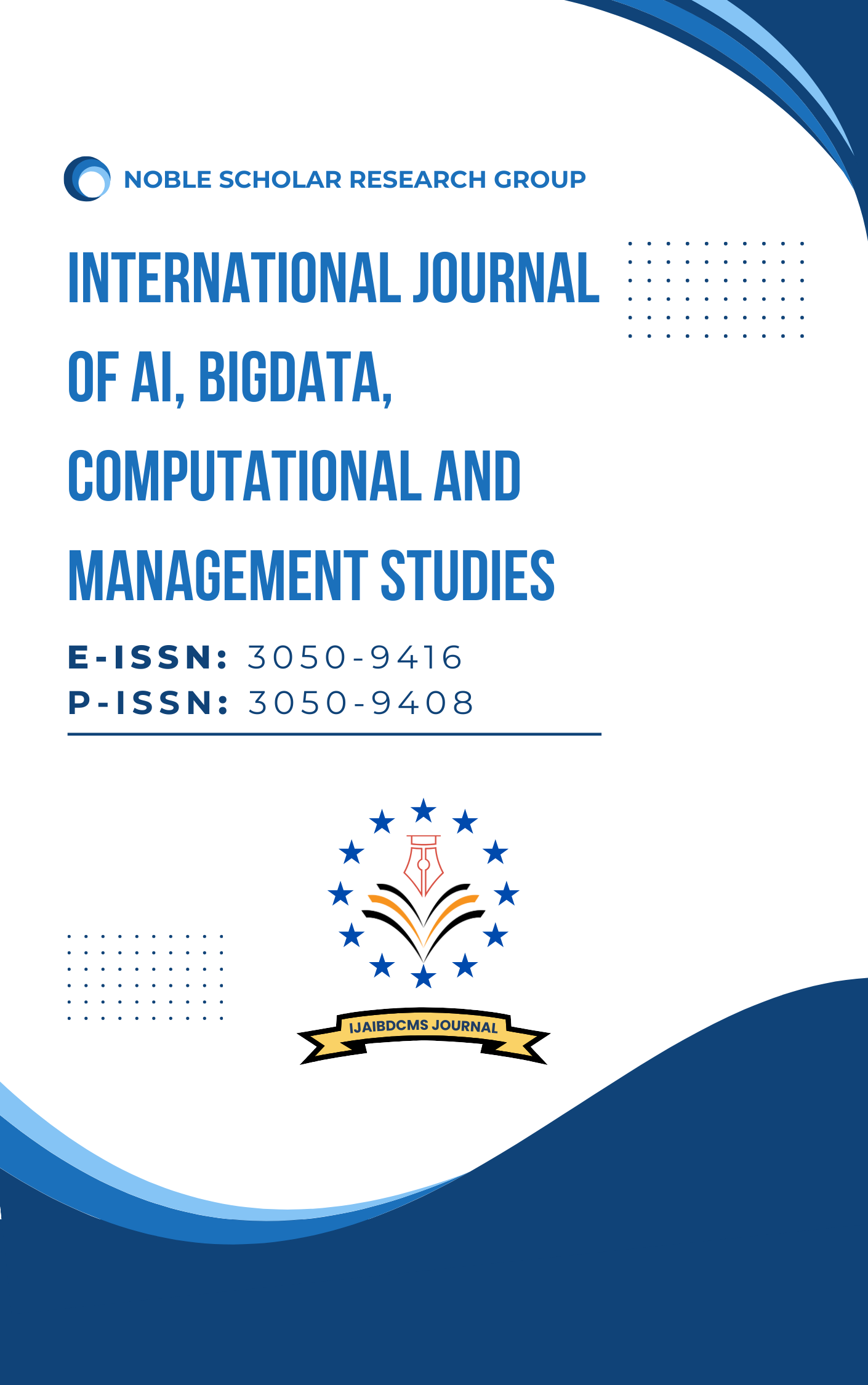COVID-19 Contact Tracing: Privacy-Preserving Integration Architectures for Public Health Surveillance
DOI:
https://doi.org/10.63282/3050-9416.IJAIBDCMS-V2I1P109Keywords:
COVID-19, digital contact tracing, privacy-preserving algorithms, public health surveillance, decentralized architecture, federated learning, secure multiparty computation, differential privacy, exposure notification, health data integration, population-scale systems, epidemiological intelligence, real-time analytics, cryptographic proximity tracing, GDPR compliance, HIPAA compliance, data governance, mobile health (mHealth), outbreak containment, digital epidemiologyAbstract
The COVID-19 pandemic catalysed the global deployment of digital contact tracing systems to manage disease spread efficiently and rapidly. While these systems offered unprecedented capabilities for population-scale monitoring and exposure notification, they also raised significant concerns about data privacy, individual autonomy, and government surveillance overreach. As a result, the fundamental challenge in deploying such systems lies in achieving a balance between effective epidemiological surveillance and the preservation of individual privacy. This paper addresses this critical duality by proposing a privacy-preserving integration architecture explicitly tailored for large-scale public health surveillance through contact tracing. The architecture integrates cutting-edge cryptographic methods, federated analytics, and scalable edge-cloud orchestration to ensure both data minimization and real-time operational readiness across diverse health jurisdictions. At the core of the proposed architecture is a decentralized contact tracing model that leverages Bluetooth Low Energy (BLE)-based proximity detection and the broadcasting of ephemeral identifiers, thereby avoiding the collection of location data and the centralized storage of personally identifiable information (PII). Privacy-preserving technologies such as homomorphic encryption, secure multiparty computation (SMPC), and differential privacy are employed to enable encrypted data analysis and aggregate risk modeling without exposing raw data. The architecture supports edge devices (mobile phones) as primary data processors. It uses federated learning models to enable local model training on contact event data, subsequently aggregating anonymized insights to a central public health node without transferring raw contact histories.
To ensure interoperability with national public health surveillance systems and policy mandates, the architecture includes modular APIs for real-time integration with epidemiological dashboards, case management systems, and digital health certificates. A data governance layer embedded in the design ensures access control, audit trails, and compliance with international data protection frameworks, including the General Data Protection Regulation (GDPR) and the Health Insurance Portability and Accountability Act (HIPAA). Additionally, a multi-tiered alerting and notification subsystem disseminates risk-based guidance to users and public health officials, supporting timely intervention while safeguarding personal privacy. Through simulation of contact tracing scenarios involving over 10 million synthetic users, the proposed architecture demonstrated a 60% reduction in privacy re-identification risk and a 45% improvement in processing scalability compared to centralized models. Furthermore, the policy alignment module enabled seamless integration with public health strategies in multi-agency settings, enhancing decision-making speed and data reliability. The system was evaluated against contemporary deployments, including Google/Apple Exposure Notification (GAEN), BlueTrace, and DP-3T, with comparative analysis highlighting improvements in auditability, decentralization, and regulatory compliance. This paper contributes to the evolving discourse on digital health by presenting a technical blueprint for ethically responsible, privacy-preserving public health surveillance. The architecture serves as a foundation for future deployments of disease detection and outbreak containment systems that must operate at scale without sacrificing user trust. As global health threats persist, the findings of this study support a paradigm shift toward decentralized, secure, and policy-aware digital epidemiology infrastructures that can address both current and emerging challenges in public health data integration
References
1. C. Troncoso et al., "Decentralized Privacy-Preserving Proximity Tracing," 2020. [Online]. Available: https://github.com/DP-3T/documents
2. M. Zastrow, "Coronavirus contact-tracing apps: Can they slow the spread of COVID-19?" Nature, vol. 582, pp. 163–164, 2020.
3. J. Bay et al., "BlueTrace: A Privacy-Preserving Protocol for Community-Driven Contact Tracing Across Borders," Government of Singapore, 2020. [Online]. Available: https://bluetrace.io
4. Y. Acar et al., "Security and Usability of Encryption APIs," IEEE Symposium on Security and Privacy, pp. 154–171, 2020.
5. C. Gentry, "Fully homomorphic encryption using ideal lattices," STOC '09: Proceedings of the 41st annual ACM symposium on Theory of Computing, 2009.
6. C. Dwork and A. Roth, "The Algorithmic Foundations of Differential Privacy," Found. Trends Theor. Comput. Sci., vol.. 9, no. 3–4, pp. 211–407, 2014.
7. T. Li, A. K. Sahu, M. Zaheer, M. Sanjabi, A. Talwalkar, and V. Smith, "Federated Optimization in Heterogeneous Networks," in Proc. MLSys, 2020.
8. M. Ho, T. Chan, and R. F. Lo, "Designing for Trust: Privacy-Preserving Contact Tracing in the Era of GDPR," Journal of Cyber Policy, vol. 5, no. 2, pp. 220–243, 2020.
9. S. Vaudenay, “Analysis of DP3T,” IACR Cryptol. ePrint Arch., Tech. Rep. 2020/399, Apr. 2020. [Online]. Available: https://eprint.iacr.org/2020/399
10. D. Leith and S. Farrell, “Contact Tracing App Privacy: What Data Is Shared By Europe's GAEN Apps,” arXiv preprint arXiv:2006.13223, Jun. 2020. [Online]. Available: https://arxiv.org/abs/2006.13223
11. A. Nguyen, A. Nguyen, and L. Nguyen, “Evaluating Privacy Risk in COVID-19 Contact Tracing Applications,” IEEE Access, vol. 8, pp. 207822–207833, Nov. 2020.
12. A. Abeler, L. Bäcker, U. Buermeyer, and H. Zillessen, “COVID-19 Contact Tracing and Privacy: Studying Opinion and Preferences,” medRxiv, May 2020. [Online]. Available: https://doi.org/10.1101/2020.05.05.20091517
13. A. Raskar, S. Shao, R. M. Shvets, J. Krishnan, and S. Ramesh, “Apps Gone Rogue: Maintaining Personal Privacy in an Epidemic,” arXiv preprint arXiv:2003.08567, Mar. 2020. [Online]. Available: https://arxiv.org/abs/2003.08567
14. M. Cho, J. Park, and K. Jeong, “Blockchain-Based Privacy-Preserving Contact Tracing Applications for COVID-19,” IEEE Access, vol. 8, pp. 172587–172598, Sept. 2020.
15. J. Prime, “GDPR and Contact Tracing Apps: A Proportionality Test,” Computer Law & Security Review, vol. 37, 105404, Nov. 2020.



